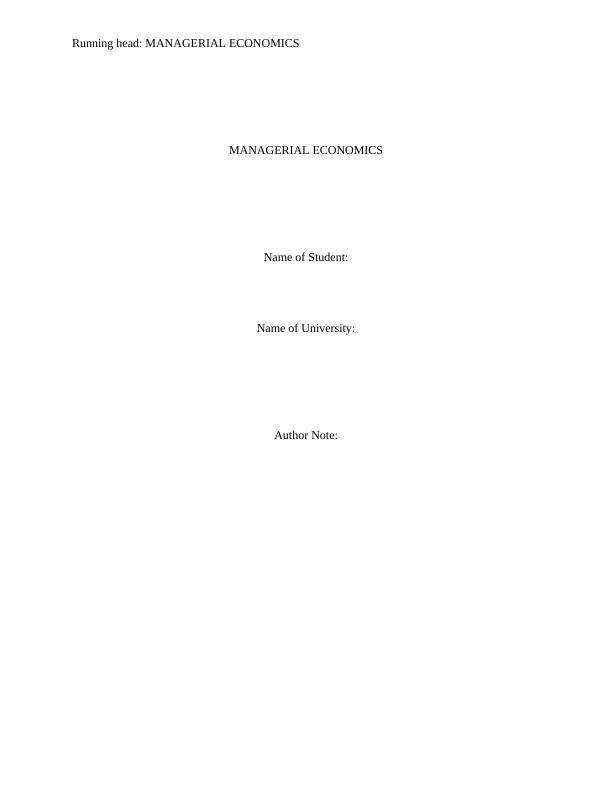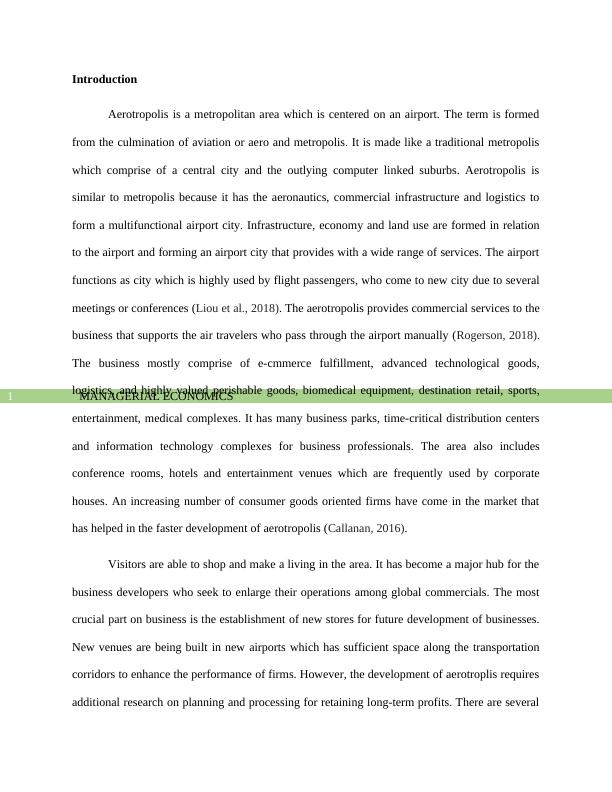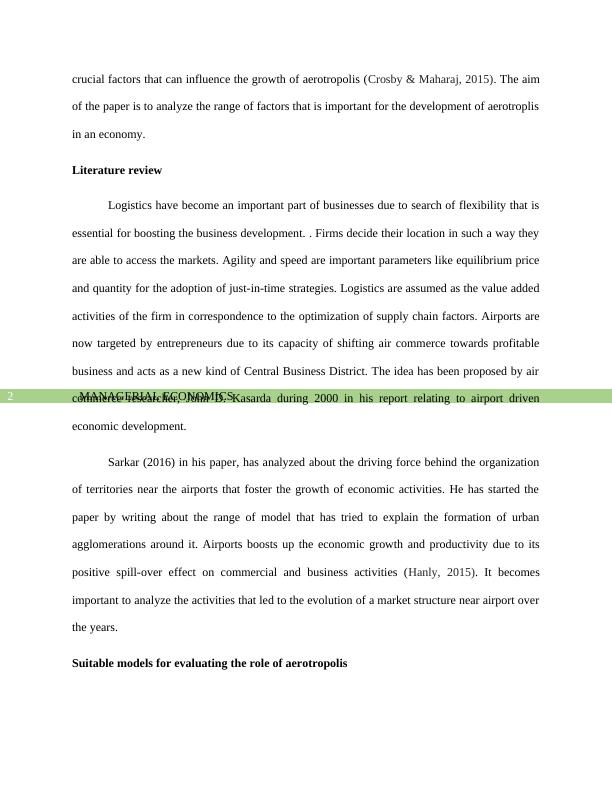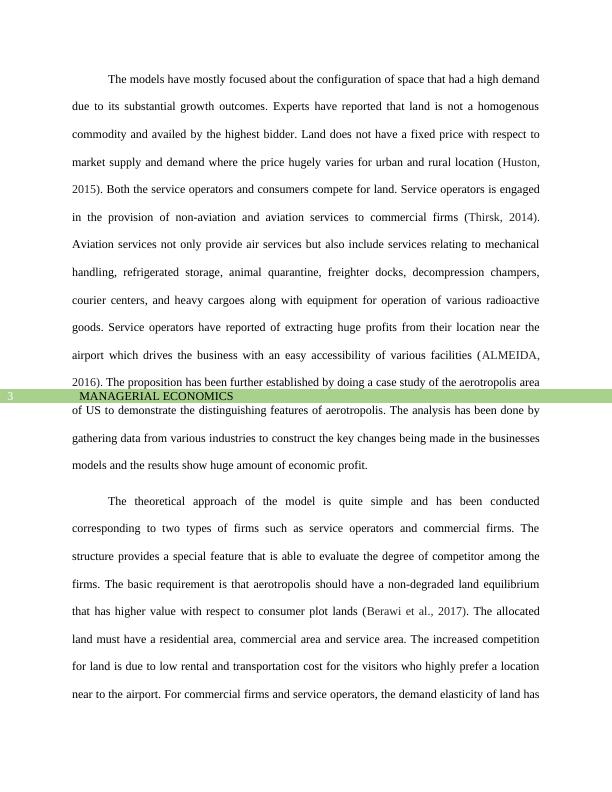Managerial Economics - Aerotropolis
13 Pages3583 Words24 Views
Added on 2022-09-07
Managerial Economics - Aerotropolis
Added on 2022-09-07
ShareRelated Documents
Running head: MANAGERIAL ECONOMICS
MANAGERIAL ECONOMICS
Name of Student:
Name of University:
Author Note:
MANAGERIAL ECONOMICS
Name of Student:
Name of University:
Author Note:

MANAGERIAL ECONOMICS1
Introduction
Aerotropolis is a metropolitan area which is centered on an airport. The term is formed
from the culmination of aviation or aero and metropolis. It is made like a traditional metropolis
which comprise of a central city and the outlying computer linked suburbs. Aerotropolis is
similar to metropolis because it has the aeronautics, commercial infrastructure and logistics to
form a multifunctional airport city. Infrastructure, economy and land use are formed in relation
to the airport and forming an airport city that provides with a wide range of services. The airport
functions as city which is highly used by flight passengers, who come to new city due to several
meetings or conferences (Liou et al., 2018). The aerotropolis provides commercial services to the
business that supports the air travelers who pass through the airport manually (Rogerson, 2018).
The business mostly comprise of e-cmmerce fulfillment, advanced technological goods,
logistics, and highly valued perishable goods, biomedical equipment, destination retail, sports,
entertainment, medical complexes. It has many business parks, time-critical distribution centers
and information technology complexes for business professionals. The area also includes
conference rooms, hotels and entertainment venues which are frequently used by corporate
houses. An increasing number of consumer goods oriented firms have come in the market that
has helped in the faster development of aerotropolis (Callanan, 2016).
Visitors are able to shop and make a living in the area. It has become a major hub for the
business developers who seek to enlarge their operations among global commercials. The most
crucial part on business is the establishment of new stores for future development of businesses.
New venues are being built in new airports which has sufficient space along the transportation
corridors to enhance the performance of firms. However, the development of aerotroplis requires
additional research on planning and processing for retaining long-term profits. There are several
Introduction
Aerotropolis is a metropolitan area which is centered on an airport. The term is formed
from the culmination of aviation or aero and metropolis. It is made like a traditional metropolis
which comprise of a central city and the outlying computer linked suburbs. Aerotropolis is
similar to metropolis because it has the aeronautics, commercial infrastructure and logistics to
form a multifunctional airport city. Infrastructure, economy and land use are formed in relation
to the airport and forming an airport city that provides with a wide range of services. The airport
functions as city which is highly used by flight passengers, who come to new city due to several
meetings or conferences (Liou et al., 2018). The aerotropolis provides commercial services to the
business that supports the air travelers who pass through the airport manually (Rogerson, 2018).
The business mostly comprise of e-cmmerce fulfillment, advanced technological goods,
logistics, and highly valued perishable goods, biomedical equipment, destination retail, sports,
entertainment, medical complexes. It has many business parks, time-critical distribution centers
and information technology complexes for business professionals. The area also includes
conference rooms, hotels and entertainment venues which are frequently used by corporate
houses. An increasing number of consumer goods oriented firms have come in the market that
has helped in the faster development of aerotropolis (Callanan, 2016).
Visitors are able to shop and make a living in the area. It has become a major hub for the
business developers who seek to enlarge their operations among global commercials. The most
crucial part on business is the establishment of new stores for future development of businesses.
New venues are being built in new airports which has sufficient space along the transportation
corridors to enhance the performance of firms. However, the development of aerotroplis requires
additional research on planning and processing for retaining long-term profits. There are several

MANAGERIAL ECONOMICS2
crucial factors that can influence the growth of aerotropolis (Crosby & Maharaj, 2015). The aim
of the paper is to analyze the range of factors that is important for the development of aerotroplis
in an economy.
Literature review
Logistics have become an important part of businesses due to search of flexibility that is
essential for boosting the business development. . Firms decide their location in such a way they
are able to access the markets. Agility and speed are important parameters like equilibrium price
and quantity for the adoption of just-in-time strategies. Logistics are assumed as the value added
activities of the firm in correspondence to the optimization of supply chain factors. Airports are
now targeted by entrepreneurs due to its capacity of shifting air commerce towards profitable
business and acts as a new kind of Central Business District. The idea has been proposed by air
commerce researcher, John D. Kasarda during 2000 in his report relating to airport driven
economic development.
Sarkar (2016) in his paper, has analyzed about the driving force behind the organization
of territories near the airports that foster the growth of economic activities. He has started the
paper by writing about the range of model that has tried to explain the formation of urban
agglomerations around it. Airports boosts up the economic growth and productivity due to its
positive spill-over effect on commercial and business activities (Hanly, 2015). It becomes
important to analyze the activities that led to the evolution of a market structure near airport over
the years.
Suitable models for evaluating the role of aerotropolis
crucial factors that can influence the growth of aerotropolis (Crosby & Maharaj, 2015). The aim
of the paper is to analyze the range of factors that is important for the development of aerotroplis
in an economy.
Literature review
Logistics have become an important part of businesses due to search of flexibility that is
essential for boosting the business development. . Firms decide their location in such a way they
are able to access the markets. Agility and speed are important parameters like equilibrium price
and quantity for the adoption of just-in-time strategies. Logistics are assumed as the value added
activities of the firm in correspondence to the optimization of supply chain factors. Airports are
now targeted by entrepreneurs due to its capacity of shifting air commerce towards profitable
business and acts as a new kind of Central Business District. The idea has been proposed by air
commerce researcher, John D. Kasarda during 2000 in his report relating to airport driven
economic development.
Sarkar (2016) in his paper, has analyzed about the driving force behind the organization
of territories near the airports that foster the growth of economic activities. He has started the
paper by writing about the range of model that has tried to explain the formation of urban
agglomerations around it. Airports boosts up the economic growth and productivity due to its
positive spill-over effect on commercial and business activities (Hanly, 2015). It becomes
important to analyze the activities that led to the evolution of a market structure near airport over
the years.
Suitable models for evaluating the role of aerotropolis

MANAGERIAL ECONOMICS3
The models have mostly focused about the configuration of space that had a high demand
due to its substantial growth outcomes. Experts have reported that land is not a homogenous
commodity and availed by the highest bidder. Land does not have a fixed price with respect to
market supply and demand where the price hugely varies for urban and rural location (Huston,
2015). Both the service operators and consumers compete for land. Service operators is engaged
in the provision of non-aviation and aviation services to commercial firms (Thirsk, 2014).
Aviation services not only provide air services but also include services relating to mechanical
handling, refrigerated storage, animal quarantine, freighter docks, decompression champers,
courier centers, and heavy cargoes along with equipment for operation of various radioactive
goods. Service operators have reported of extracting huge profits from their location near the
airport which drives the business with an easy accessibility of various facilities (ALMEIDA,
2016). The proposition has been further established by doing a case study of the aerotropolis area
of US to demonstrate the distinguishing features of aerotropolis. The analysis has been done by
gathering data from various industries to construct the key changes being made in the businesses
models and the results show huge amount of economic profit.
The theoretical approach of the model is quite simple and has been conducted
corresponding to two types of firms such as service operators and commercial firms. The
structure provides a special feature that is able to evaluate the degree of competitor among the
firms. The basic requirement is that aerotropolis should have a non-degraded land equilibrium
that has higher value with respect to consumer plot lands (Berawi et al., 2017). The allocated
land must have a residential area, commercial area and service area. The increased competition
for land is due to low rental and transportation cost for the visitors who highly prefer a location
near to the airport. For commercial firms and service operators, the demand elasticity of land has
The models have mostly focused about the configuration of space that had a high demand
due to its substantial growth outcomes. Experts have reported that land is not a homogenous
commodity and availed by the highest bidder. Land does not have a fixed price with respect to
market supply and demand where the price hugely varies for urban and rural location (Huston,
2015). Both the service operators and consumers compete for land. Service operators is engaged
in the provision of non-aviation and aviation services to commercial firms (Thirsk, 2014).
Aviation services not only provide air services but also include services relating to mechanical
handling, refrigerated storage, animal quarantine, freighter docks, decompression champers,
courier centers, and heavy cargoes along with equipment for operation of various radioactive
goods. Service operators have reported of extracting huge profits from their location near the
airport which drives the business with an easy accessibility of various facilities (ALMEIDA,
2016). The proposition has been further established by doing a case study of the aerotropolis area
of US to demonstrate the distinguishing features of aerotropolis. The analysis has been done by
gathering data from various industries to construct the key changes being made in the businesses
models and the results show huge amount of economic profit.
The theoretical approach of the model is quite simple and has been conducted
corresponding to two types of firms such as service operators and commercial firms. The
structure provides a special feature that is able to evaluate the degree of competitor among the
firms. The basic requirement is that aerotropolis should have a non-degraded land equilibrium
that has higher value with respect to consumer plot lands (Berawi et al., 2017). The allocated
land must have a residential area, commercial area and service area. The increased competition
for land is due to low rental and transportation cost for the visitors who highly prefer a location
near to the airport. For commercial firms and service operators, the demand elasticity of land has

End of preview
Want to access all the pages? Upload your documents or become a member.
Related Documents
NEW WESTERN SYDNEY AIRPORT AT BADGERYS CREEK, NSW Name oflg...
|15
|2844
|82
Event Management And Performancelg...
|38
|9857
|56
Opportunity, Innovation, and Entrepreneurship in Logistics and Transportation Sectorlg...
|11
|2936
|451
New Urbanism: A Development and Planning Tacticlg...
|10
|2755
|57
Global Business and Sustainability Name of the Student Name of the University Author's notelg...
|12
|3695
|257
Sustainability Issues of Urban Development and Metro Strategy in the Sydney with Baulkham Hills of New South Waleslg...
|18
|4249
|474
